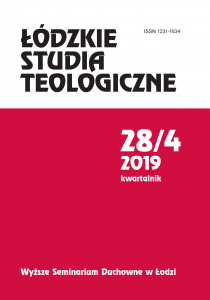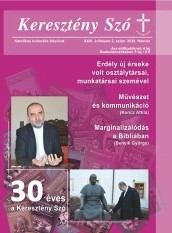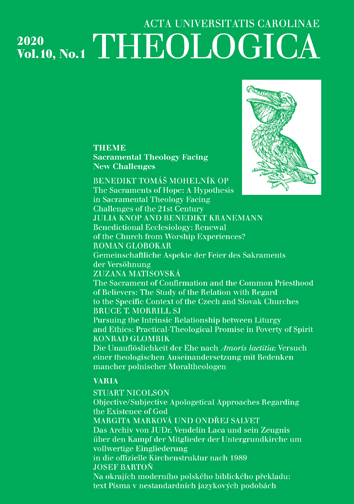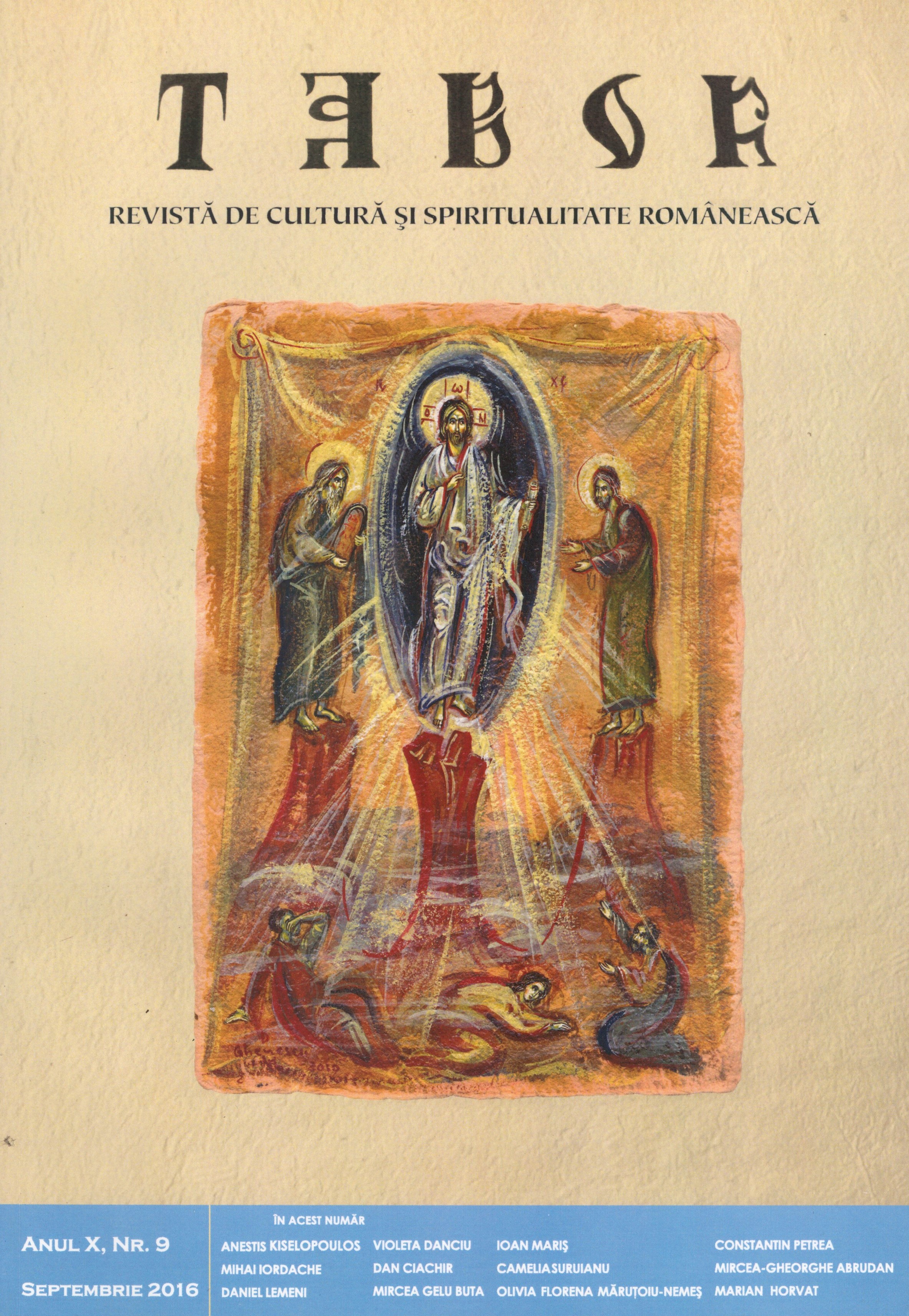
We kindly inform you that, as long as the subject affiliation of our 300.000+ articles is in progress, you might get unsufficient or no results on your third level or second level search. In this case, please broaden your search criteria.


The article describes the history of the formation of the biblical unit Zec 11:4-17 and changes in its meaning at particular editorial stages. Originally the fragment was a reflection of an event consisting in the breakdown of the relationship between Judah and the northern part of the country (probably Samaritans). In the next editorial stage, verses 12-13 were included, and later 8a. These additions were the result of a change in the interpretation of the fragment - it was viewed as relating to the history of the split between Judah and the northern kingdom after Solomon’s death. After these additions, the pericope became a reflection on the history of Israel enclosed in the form of a prophetic symbolic act. The last addition was the introduction of verses 15-17 which were an announcement of the future.
More...![Rekontekstualizacja i reinterpretacja Psalmu 18[17],5a i Ps 16[15],8-11 w kazaniu Piotra w Dz 2,22-33](/api/image/getissuecoverimage?id=picture_2019_52320.jpg)
The article aims to examine the way in which quotes from Ps 18 [17]:5a and 16 [15]:8-11 were used in the Peter’s First Speech (Acts 2:14-39).They are analyzed the Greek expressions: “releasing from the pain of death” [lu,saj ta.j wvdi/naj tou/ qana,tou] (Acts 2:24), “decay” (of the body) [diafqora,] (Acts 2:27) and “hope” [evlpi,j] (Acts 2:26). These terms do not appear in the Hebrew Psalms. The literal reading of the Greek version of Ps 16 [15]:8-11 allows for its Christological, resurrectional and eschatological interpretation. However, a return to the Hebrew text allows us to reconstruct the original messianic context of this psalm and the promise for the dynasty of David and refer this psalm personally to Jesus. In addition, the soteriological interpretation of Ps 18 [17]:5 is based on the Hebrew text. This means that the reconstruction of Peter’s First Speech is based not only on the Greek texts, but also on the Hebrew Psalms and incorporates traditional material from Judeo-Christian sources (testimonia, florilegia). Because the environmental Bible of Helleno-Christian recipients (both virtual and first historical recipients) of the Acts was the LXX, the author of the Acts finally decided to replace the original Hebrew texts with quotes from the LXX.
More...
The main objective of this article is to confront a complex exegesis history of the parable of ten virgins (Matt 25:1–13) with contemporary attempts to understand it with the application of historical-critical method. The historical-critical method presents a number of issues from the area of text criticism and editorial process, which have influenced the understanding of the parable throughout the ages. The most important questions concerns the identity of the Bridegroom: is this Jesus or a personalization of social injustice?
More...
In contemporary research, the prevailing view is that the Therapeuts, of which Philo of Alexandria writes in Vita Contemplativa, were a Jewish group or sect. There is also an opinion that Therapeuts are the product of Philo’s utopian fantasy. In both cases, the report of Eusebius of Caesarea in the Church history is dismissed as unfounded. In this paper, we will outline the reasons why we believe that Eusebius’s view cannot be rejected as unfounded, and that it is more convincing than alternative assumptions.
More...
The pericope of the anointment of Bethany in John’s account raises some question marks in the world of specialists with respect to the historicity of the scene and of the characters, on one hand, the integrity of the text being another source of debates, on the other hand. Instead, the variations of the manuscripts are minor, affecting at a minimal level the theological flow and the stream of ideas of the pericope. In order to clarify the source text, it was necessary to resort to the methodology of editorial and literary criticism, carried out by means of the most modern biblical instruments, in order to put forward a textual reconstruction as close to the original as possible. Therefore, the verbs (ho tethnekōs / echōn), the nouns (Ioudas ho Iskariōtes / Ioudas Simōnos Iskariōtes) and the problematic conjunctions (kaí / ína) were analysed in detail according to the requirements of a critical-textual approach. After finishing this technical endeavour, we initiated the process of translating the reconstructed text into Romanian, bearing in mind both the philological and the theological dimension, in an attempt to offer as accurate a translation as possible, in view of a future exegetical and theological study on the anointment of Bethany. For this purpose, we analysed the first Romanian biblical translations of the 17th century and the modern translations, including the Synodal, Anania, Bădiliţă and SBIR (Romanian Interconfessional Biblical Society) editions, mark- ing in bold in the source text slight translation deficiencies. In conclusion, we present our version of translation of the text in John 12:1-8, encouraging specialists to provide an assessment on the validity of our endeavour.
More...
Fall of 2019, a book ranked first in book sales for weeks. The book, whose title did not promise anything exceptional, was Soif (Ed. Albin Michel) (Sete), unarticulated, and the author Amelie Nothomb, prose writer translated into dozens of foreign languages, in hundreds of thousands of copies. After bearing it in her mind for fifty years, Amelie Nothomb manages to write the book of her life “all at once” in 2018. She does so with what she remembers from the evangelical readings and Catholic catechism, but mostly with a prodigious interpretive imagination. In the gospels she finds many things that “don’t hold water” and which she sanctions drastically. The author builds her own thinking system where Christ is idealized as a divine-human being.
More...
The nine volumes, translated from Greek and printed by Theodosius Athanasiu during 22 years, almost 100 years after their appearance, did not know the same spread through subsequent corrections, occasioned by the commemoration of St. John Chrysostom at 1600 years since moving to eternity. Theodosius Athanasiu uses in his translation the edition from Holy Scriptures named Bible of Buzău (1854-1856), which displeased him because of the many passages not consistent with the version used by St. John Chrysostom and which he is forced to rephrase. In Commentaries of Hebrews epistle use the Synodal edition of Bible (1914). He done this translation of John Chrysostom’s Commentaries to the Pauline Epistles for the service of Orthodox Christians and for the glory of the Most High, who poured out this talent.
More...
The present study addresses a theme of interest not only for the new testamentary theology, but also for other related theological disciplines. In the present study, we will focus mainly on an exegetical research, but we will not ignore the information coming from the historical branch, given the context in which the Apostolic Synod of Jerusalem took place. The story of the first Synod in the history of the Christian Church is made exhaustively by the Holy Evangelist Luke in his book, The Acts of the Holy Apostles, in chapter 15, 1-35, but references to this major event in the life of the Primary Church will also make one of actively involved in the works of the synod, namely, the Apostle Paul, in the Epistle to Galatians 2, 1-10. In the isagogical part of this study, we briefly presented the work of the Holy Apostles to preach the Gospel to all nations according to the commandment of the Savior Jesus Christ (Mt. 28,19), then to make known the motivation and necessity of convening the Apostolic Synod of Jerusalem. In the steps taken, the presentation of the pleadings in the proceedings of the Synod, the analysis and the finality of the debates, was the focus of my concerns, finally pointing out that the Apostolic Synod of Jerusalem decided that the Mosaic Law would not apply to the Gentile Christians to any person who wants to adhere to the faith in Christ, while affirming Christian freedom to the Mosaic Law.
More...
The present article aims two major goals. Firstly, this paper will mainly cover the issue of the term μορφή (Php 2, 6-7), a term with decisive importance in the understanding of the fragment Php 2, 5-11, known under the name of the Christological Hymn (or Carmen Christi). Secondly, this academic endeavor tries to propose an exegetic methodology specific to the orthodox space that doesn't yet suggest, within modern exegesis, any well-defined approach method. Our endeavor starts from the lack of such presentation in specialized articles from our country, but also from the need to present the Orthodox point of view along with the Western one. This term will be analyzed in the two phrases used in the hymn, ‘μορφή Θεού’ (Php 2, 6) and ‘μορφή δούλου’ (Php 2, 7). We thus suggest the use of a methodology that combines the historical-critical method with the resort to the Holy Fathers’ theology.
More...
The article analyses a few texts of the New Testament (Matthew 9.1-8, Mark 2.1-12, Luke 5.17-26, Jacob 5.13-18, 1 John 1.8-2.2) that describe certain conditions that allow man to receive forgiveness of sins from God’s side. They are: faith, prayer rooted in faith, anointment in the name of the Lord by priests and confession of sins. What can be concluded from the texts in question is that God is ready to forgive man sins, but what is required is human cooperation. The said texts cast light on certain statements from the New Testament in which forgiveness of sins is accompanied by no conditions and help to understand that God’s mercy call for certain conditions on the sinner’s side.
More...
Contemporary interpretation of the Scriptures should not ignore, besides the contextual and historical dimension, the aspect of discreet sacred symbolism. Based on our linguistic and religious knowledge, we proposed a three-layered model of interpretation of the biblical content. Given the proposed exegetic solutions, we validated the applied model against two biblical concepts, namely God’s Image and the Blessed Virgin Mary.
More...



In the context of the impressive doctrinal density that Luke has provided to chapter 24 of his Gospel, there is a question that aroused many times, whether dinner at Emmaus was a Eucharistic celebration or not. Currently, discussions of exegetes lead to a double possibility of expressing Luke 24, 30-32.35: the „Eucharistic cliché” of blessing the bread or the „recognition” of risen Jesus in the breaking of the bread. In other news, they wonder whether the dinner at Emmaus is an intimate dinner of transcendent and eschatological nature where the objective of the narrative is to demonstrate that Jesus is risen and recognized through his typical gestures or it is a private eucharistic dinner where the risen Christ reveals Himself to His disciples in the breaking of the bread.
More...
In this study I tried to argue that the eucharistic words occupy the central place in Jesus self-disclosure, and therefore they offer a crucial key to understanding his person and work. Firstly, I made an introduction including the view of the johannine community on the Eucharist and the significance of this event in it.To develop this ideea, I have divided my article in three chapters: 1. Eucharistic reality in pauline perspective. 2. Ὁ υἱὸς τοῦ ἀνθρώπου between divinity and humanity in johannine community. 3. Eucharist, viewed as a reality and transfiguration.Beginning with the Preliminaries, I presented the goal of my approach in exploring the meaning of the Eucharist statement, in a variety of theological interpretations by using the linguistic method and theological vision.In the first chapter I presented the outlook of Saint Paul in biblical texts with regard to the significance of bread and wine as flesh and blood of Christ. Furthermore in the second and third chapters, I analyzed the vision of the johannine community, who understood differently the work and ministry of the „Son of man”. By emphasizing this aspect, I used a variety of text interpretations in order to give an understanding of what is in the reallity the „Son of Man”, and his relationship with the Eucharist.
More...
Procula exists because of her dream and, above all, because of her determination to make this dream known to her husband. The privilege of being chosen as the recipient of a sign is what gave life to this character, and her life, until hard evidence or written records that must exist somewhere are discovered, is just a guess. Only one event and one record, with no other parallel places to confirm the reality or the objectivity of this account of what happened. Without verse 19 of chapter 27 from the Gospel of Matthew, nobody would have asked if Pilate had a wife or if she had something to say about Jesus Christ. She could have forever remain a secret follower of Christ or ignorant of Him. Matthew brings to light the vague image of this woman, which he outlines only by suggestions and not by clear accents, and then gives her a place in history, secondary it is true, but memorable, just as he had done with the myrrh-bearing woman from Bethany. The episode inserted by the evangelist Matthew in 27:19 is not the story of a failed attempt, but he immediately finds his answer in the equally intriguing episode of Pilate’s washing of hands, and a second answer in the prospect of opening the dialogue between God and the Gentiles.
More...
This essay depicts, from an exegetical point of view, the mere coordinates of King Solomon special verse regarding the nature of wisdom. Begining with a noun („fear”) in this case, wisdom or knowledge (like ESV Bible translates it), it is the core of the book, because the quest for wisdom begins with the fear of the Lord. The reason why the fear of the Lord is the beginning of both knowledge and wisdom is that moral life begins with reverence and humility before the Maker and Redeemer. The idea of a quest for knowledge sets biblical wisdom in the broad context of the ancient searching for truth. In addition, the verse asserts that fools despise wisdom and instruction, thus setting up the alternative between the two ways of wisdom and foolishness. This contrast dominates the entire book of Proverbs.
More...
The article presents a new translation of the Prologue to Ben Sira into Russian. The translation is supplied with commentaries and an overview on the problems with the interpretation.
More...